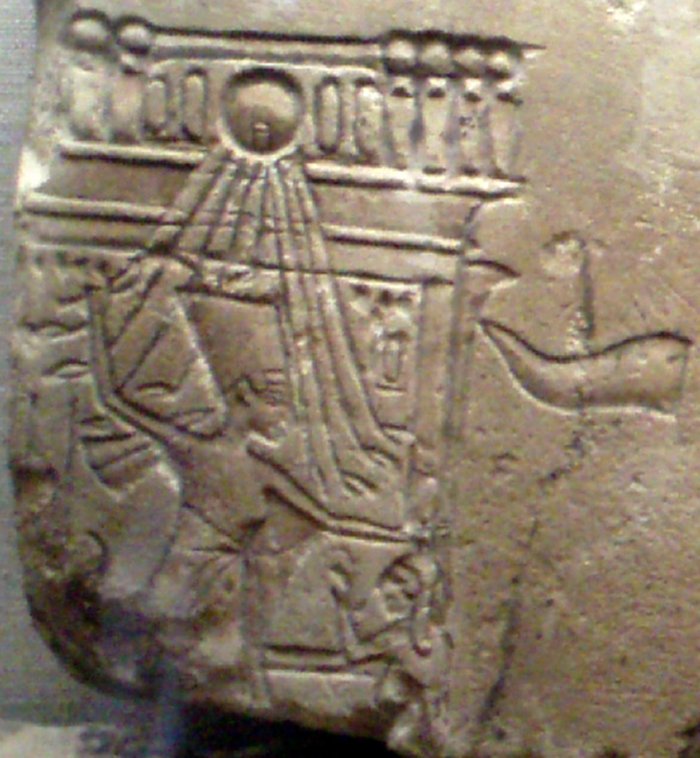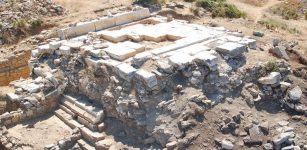What Happened To The Mysterious And Beautiful Queen Nefertiti?
Thalia Lightbringer - AncientPages.com - Nefertiti, the most powerful woman of her time, is now a symbol of ancient Egypt. What do we know about her life? Why did she suddenly disappear after being elevated to near-equal status by King Akhenaten?
Nefertiti - The Beautiful One
“Nefertiti” is translated as “The Beautiful One Has Come” but the word “nefer” means more than just beauty. It can also be translated as “goodness” and “perfection”. Egyptian hieroglyphs have layers of meaning. There must also have been more to Nefertiti’s than beauty, or she would not have been shown as such a beloved and powerful figure, the equal of the king in all things.
Granite head statue of Nefertiti. The securing post at the head apex allows for different hairstyles to adorn the head. Altes Museum, Berlin. Image credit: Keith Schengili-Roberts - CC BY-SA 3.0
Nefertiti has become an icon of beauty the world over since her bust was recovered from the sands of Egypt. She is a legendary figure, almost as symbolic of Egypt as the pyramids of Giza. But this was not so for the ancient Egyptians!
After the end of Akhenaten’s reign, there was a systematic attempt to erase all trace of him and his supporters from memory. Queen Nefertiti was not spared. She was just as controversial, shown in some scenes driving her own chariot, or acting as a warrior, not usual things for women.
Breaking With Tradition
Nefertiti was of the eighteenth dynasty, the fourteenth century BC. Some think she was the daughter of Ay, brother to Queen Tiye, wife of Amunhotep III. However, DNA evidence from the mummy believed now to be Nefertiti says otherwise. It also shows she was not the sister or cousin of Akhenaten. Some think she may have been a foreign princess, perhaps Tadukhipa of Mitanni.
Akhenaten’s father broke with tradition, moving the capital from Memphis to Thebes and marrying Tiye, a commoner. Akhenaten continued to break tradition by changing the religion to a monotheistic cult of the Aten.
After Nefertiti became a supporter of the Aten, she changed her name to Neferneferuaten ("beautiful and good is the perfection of Aten”) Egyptian rulers had many names and titles. Some of hers that we know are Lady of Grace, Sweet of Love, and Lady of all Women. She must have been very loved because Nefertiti had six daughters by Akhenaten! Nefertiti is portrayed as the king’s closest companion. In year 12 of his reign, at a huge public celebration, she is shown as his co-regent.
Was Nefertiti Smenkare?
Smenkare then appeared from nowhere, taking the place of Nefertiti at the end of Akhenaten’s rule and ruling for about 3 years afterward. The plague struck the city in the 13th year of Akhenaten’s reign, even spreading to the royal palace. In the year 14 of Akhenaten’s reign, Nefertiti vanished. Maybe Nefertiti died from the plague, as some have theorized, but the fact that she is shown in place of the protective goddesses on the four corners of Akhenaten’s sarcophagus suggests otherwise and could be evidence she performed the “Opening of the Mouth” ceremony that the Egyptians believed gave immortality, generally done by the heir to the throne.
Akhenaten died in year 17 of his reign and was buried in a tomb 4 miles from Amarna which faced the rising sun. Nefertiti was supposed to have been buried in this same tomb, but the chambers prepared for her there were never used and left unfinished, whereas Akhenaten’s part of the tomb was finished.

Close-up of a limestone relief depicting Nefertiti smiting a female captive on a royal barge. Image credit: Captmondo - CC BY-SA 3.0
Smenkare as shown in the art seems a very effeminate man and has features like Nefertiti’s. Many scholars now believe that Nefertiti was in fact Smenkare, assuming this role to solidify her position as co-ruler. Queen Hatshepsut is also shown as a male with a royal beard in some portrayals. Nefertiti was always shown as a strong and powerful queen, but appearing as a man could convey strength to the people.
Nefertiti (or Smenkare) was on shaky ground as soon as Akhenaten died. Though a supporter of the Aten, the new ruler soon decided it was wise to embrace the old traditions once again. Akhenaten’s body was taken from his tomb, moved to the Valley of the Kings when the royal family moved back to Thebes. The temples were reopened and the priests of Amun restored. However, it does not appear to have been enough. Smenkare only reigned for about a year after, and there are indications of foul play surrounding the death.
The Mummy That Might Be Nefertiti
In 1999, Marianne Luban published a web article called, “Do We Have the Mummy of Nefertiti?” which postulated that one of a trio of unidentified mummies found in a walled-up chamber of KV 35 (KV=King’s Valley) could be Nefertiti. This mummy was initially thought to be a young man, but later analysis of the remains show it to be a female whose body was severely mutilated after death. The face and chest were hacked open and the right arm torn off.
Though she never mentioned Marianne’s work, causing quite a controversy by this and not revealing her true purpose in studying this mummy, Egyptologist Dr. Joann Fletcher came to all the same conclusions after scientific tests, as well as finding the missing right arm. After DNA tests, Zahi Hawass also confirmed the mummy's identity as Nefertiti.
It seems that someone was so angry at this person that they would deny them entrance to the afterlife by making it impossible for the deceased to speak its name to the gods and obtain immortality in the afterlife.
Egyptian papyrus with a portrait of Nefertiti. Credit: Adobe Stock - Zakharchenko
Though mysteries remain about Nefertiti’s life, it seems the question of where she disappeared to has been answered! It is likely she became known as Smenkare, trying to rebuild the lost faith of the people, only to meet her end shortly after in a violent manner.
The tests done on the mummy in KV 35 show that she received a knife wound in the side shortly before death, and then after death was further mutilated. As much as possible, all traces of her were obliterated from the histories and the monuments. However, those who wanted her forgotten failed. Nefertiti did not remain in obscurity and is now one of the most famous figures of ancient Egypt, her name spoken everywhere.
Updated on July 14, 2024
By Thalia Lightbringer – AncientPages.com Staff Writer
Copyright © AncientPages.com All rights reserved. This material may not be published, broadcast, rewritten or redistributed in whole or part without the express written permission of AncientPages.com
Expand for referencesMore From Ancient Pages
-
 Qanat Firaun -‘Canal Of The Pharaohs’ Is The Ancient World’s Longest Underground Tunnel
Featured Stories | Mar 10, 2022
Qanat Firaun -‘Canal Of The Pharaohs’ Is The Ancient World’s Longest Underground Tunnel
Featured Stories | Mar 10, 2022 -
 Ancient Romans Loved White Teeth – All Means Were Acceptable To Get Them Even Portuguese Urine
Ancient History Facts | Dec 10, 2017
Ancient Romans Loved White Teeth – All Means Were Acceptable To Get Them Even Portuguese Urine
Ancient History Facts | Dec 10, 2017 -
 Byzantine Granary With 11 Pithoi Found In Byzantine City Of Amorium In Central Turkey
Archaeology | Aug 5, 2020
Byzantine Granary With 11 Pithoi Found In Byzantine City Of Amorium In Central Turkey
Archaeology | Aug 5, 2020 -
 Statuettes Of Gods And Goddesses Unearthed At Ancient Site Of Kültepe
Archaeology | Sep 16, 2020
Statuettes Of Gods And Goddesses Unearthed At Ancient Site Of Kültepe
Archaeology | Sep 16, 2020 -
 Antediluvian Artifact Discovered In Egyptian Tomb May Solve The Great Pyramid Mystery?
Ancient Mysteries | May 3, 2018
Antediluvian Artifact Discovered In Egyptian Tomb May Solve The Great Pyramid Mystery?
Ancient Mysteries | May 3, 2018 -
 10 Incredible And Bizarre Ancient Cases Of Mass Hysteria
Featured Stories | Jul 14, 2015
10 Incredible And Bizarre Ancient Cases Of Mass Hysteria
Featured Stories | Jul 14, 2015 -
 Excavations Begin In Ancient City Of Antiocheia Ad Cragnum, Turkey
Archaeology | Sep 4, 2015
Excavations Begin In Ancient City Of Antiocheia Ad Cragnum, Turkey
Archaeology | Sep 4, 2015 -
 Anu: Supreme Ruler Of The Heavenly Abode In Sumerian Pantheon Of Gods
Featured Stories | Jun 7, 2018
Anu: Supreme Ruler Of The Heavenly Abode In Sumerian Pantheon Of Gods
Featured Stories | Jun 7, 2018 -
 DNA From Doggerland That Separates The UK From Europe – New Study
Archaeology | Jul 20, 2020
DNA From Doggerland That Separates The UK From Europe – New Study
Archaeology | Jul 20, 2020 -
 Vikings And The Runic Calendar
Artifacts | Mar 4, 2016
Vikings And The Runic Calendar
Artifacts | Mar 4, 2016 -
 Ancient Entrance Gate Found In Biblical City Of Bethsaida (Zer) Where Jesus Performed His Deeds Of Power
Archaeology | Jul 11, 2018
Ancient Entrance Gate Found In Biblical City Of Bethsaida (Zer) Where Jesus Performed His Deeds Of Power
Archaeology | Jul 11, 2018 -
 8200-Year-Old ‘Viste Individual’ – DNA Analysis May Shed Light On Early Migration To Norway
Archaeology | Dec 6, 2015
8200-Year-Old ‘Viste Individual’ – DNA Analysis May Shed Light On Early Migration To Norway
Archaeology | Dec 6, 2015 -
 Egyptian Priest Sonchis Of Sais And His Story About Atlantis – Were The Shemsu Hor Survivors Of A Great Catastrophe That Ended The Ice Age?
Ancient Mysteries | Jun 8, 2017
Egyptian Priest Sonchis Of Sais And His Story About Atlantis – Were The Shemsu Hor Survivors Of A Great Catastrophe That Ended The Ice Age?
Ancient Mysteries | Jun 8, 2017 -
 Fantastic Discovery At Hadrian’s Wall Reported By Archaeologists
Archaeology | Sep 10, 2022
Fantastic Discovery At Hadrian’s Wall Reported By Archaeologists
Archaeology | Sep 10, 2022 -
 Major Discovery Of Ancient Roman Temple – Largest Evidence Ever Of The Imperial Cult
Archaeology | Jan 5, 2024
Major Discovery Of Ancient Roman Temple – Largest Evidence Ever Of The Imperial Cult
Archaeology | Jan 5, 2024 -
 Ancient Statue Of Makara, Legendary Sea-Creature Found In Cambodia
Archaeology | Jan 29, 2020
Ancient Statue Of Makara, Legendary Sea-Creature Found In Cambodia
Archaeology | Jan 29, 2020 -
 Don’t Underestimate The Rishis – Ancient Sages Were ‘Probably Great Scientists’
News | Sep 26, 2015
Don’t Underestimate The Rishis – Ancient Sages Were ‘Probably Great Scientists’
News | Sep 26, 2015 -
 Nue – Mysterious Mythological Shape-Shifting Creature Transforming Into A Black Cloud
Featured Stories | Jun 12, 2020
Nue – Mysterious Mythological Shape-Shifting Creature Transforming Into A Black Cloud
Featured Stories | Jun 12, 2020 -
 Neanderthal Genes Influence Your Mood And Much More – Study Shows
Archaeology | Oct 6, 2017
Neanderthal Genes Influence Your Mood And Much More – Study Shows
Archaeology | Oct 6, 2017 -
 Hogmanay: Scotland’s New Year Celebration Inherited From The Vikings
Ancient Traditions And Customs | Dec 31, 2024
Hogmanay: Scotland’s New Year Celebration Inherited From The Vikings
Ancient Traditions And Customs | Dec 31, 2024


